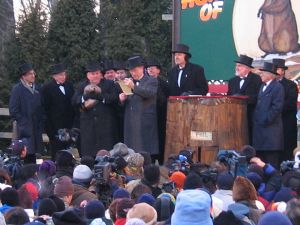Groundhog Day
Groundhog Day or Groundhog's Day is a traditional festival celebrated in the United States and Canada on February 2. It was originally a cross-quarter day, midway between the Winter Solstice and the Vernal Equinox. However, before the adoption of the Gregorian Calendar, precession has caused the cross-quarter day to fall four days later.
In traditional weather lore, if a groundhog emerges from its burrow on this day and fails to see its shadow because the weather is cloudy, winter will soon end. If the groundhog sees its shadow because the weather is bright and clear, it will be frightened and run back into its hole, and the winter will continue for six more weeks.
History
Around the fifth century, the European Celts believed that animals had certain supernatural powers on special days that were half-way between the Winter Solstice and Spring Equinox.[citation needed] Folklore from Germany and France indicated that when marmots and bears came out of their winter dens too early, they were frightened by their shadow and retreated back inside for four to six weeks.[citation needed] This may have been adopted by the Romans as Hedgehog Day. In Scotland the hedgehog has long been revered for its healing powers (as referenced in Robert Burns' Ode to a Hedgehog).
The earliest known American reference to Groundhog Day can be found at the Historical Society of Berks County in Reading, Pennsylvania. The reference was made Feb. 4, 1841 in Morgantown, Berks County, Pennsylvania storekeeper James Morris' diary: "Last Tuesday, the 2nd, was Candlemas day, the day on which, according to the Germans, the Groundhog peeps out of his winter quarters and if he sees his shadow he pops back for another six weeks nap, but if the day be cloudy he remains out, as the weather is to be moderate."
In the U.S. the tradition derives from a Scottish poem:
- As the light grows longer
- The cold grows stronger
- If Candlemas be fair and bright
- Winter will have another flight
- If Candlemas be cloud and rain
- Winter will be gone and not come again
- A farmer should on Candlemas day
- Have half his corn and half his hay
- On Candlemas day if thorns hang a drop
- You can be sure of a good pea crop
This tradition also stems from similar beliefs associated with Candlemas Day [1] and Hedgehog Day. Candlemas, also known as the Purification of the Virgin or the Presentation, coincides with the earlier pagan observance Imbolc.
In western countries in the Northern Hemisphere the official first day of Spring is about six weeks after Groundhog Day, on March 20 or 21. About 1,000 years ago, before the adoption of the Gregorian calendar when the date of the equinox drifted in the Julian calendar, the spring equinox fell on March 16 instead. This was exactly six weeks after February 2. Assuming that the equinox marked the first day of spring in certain medieval cultures, as it does now in western countries, Groundhog Day occurred exactly six weeks before spring. Therefore, if the groundhog saw his shadow on Groundhog Day there would be six more weeks of winter. If he didn't, there would be 42 more days of winter. In other words, the Groundhog Day tradition may have begun as a bit of folk humor.
Alternatively, the custom could have been a folk embodiment of the confusion created by the collision of two calendrical systems. Some ancient traditions marked the change of season at cross-quarter days such as Imbolc when daylight first makes significant progress against the night. Other traditions held that Spring did not begin until the length of daylight overtook night at the Vernal Equinox. So an arbiter, the groundhog / hedgehog, was incorporated as a yearly custom to settle the two traditions. Sometimes Spring begins at Imbolc, and sometimes Winter lasts 6 more weeks until the Equinox.
Famous prognosticating groundhogs
- Wiarton Willie found in Wiarton, Ontario
- Punxsutawney Phil found in Punxsutawney, Pennsylvania
- Staten Island Chuck found in New York City, New York
- General Beau Lee, PhD found in Atlanta, Georgia
- Malverne Mel and Malverne Melissa found in Malverne, New York
Past predictions
- 2007
- 6 more weeks of winter — Jimmy the Groundhog, Holtsville Hal, Dunkirk Dave
- Early Spring — Punxsutawney Phil, Staten Island Chuck, Wiarton Willie, Shubenacadie Sam and General Beauregard Lee of Georgia, Malverne Mel
- 2006
- 6 more weeks of winter — Dunkirk Dave, Punxsutawney Phil, Buckeye Chuck
- Early Spring — Spanish Joe, Wiarton Willie, General Beauregard Lee, Staten Island Chuck, Shubenacadie Sam, Jimmy the Groundhog, Malverne Mel, French Creek Freddie
- 2005
- 6 more weeks of winter — Dunkirk Dave, Punxsutawney Phil, Shubenacadie Sam, Spanish Joe, Octorara Orphie, Malverne Mel
- Early Spring — Wiarton Willie, Jimmy the Groundhog, General Beauregard Lee, Balzac Billy, Staten Island Chuck
- 2004
- 6 more weeks of winter — Punxsutawney Phil, Dunkirk Dave, Wiarton Willie, Spanish Joe, Balzac Billy, General Beauregard Lee, Malverne Mel
- 2003
- Early Spring — Dunkirk Dave
- 2002
- 6 more weeks of winter — Dunkirk Dave
- 2001
- Early Spring — Dunkirk Dave
In fiction
In the 1979 Rankin-Bass Christmas TV special Jack Frost, a crucial plot point in the story involves Jack casting his own shadow on Groundhog Day for six more weeks of winter. At the end of the story it is revealed that the unseen narrator is the groundhog.
The 1993 comedy movie Groundhog Day takes place in Punxsutawney, Pennsylvania on this day (although the majority of the movie was actually filmed in Woodstock, Illinois). The main character (played by Bill Murray) is forced to relive the day over and over again until he can learn to give up his selfishness and become a better person. The movie consistently rates among the IMDB's Top 250 movies as voted by users.
On January 9 2006, the Pennsylvania Tourism Office presented installments of the Groundhog 202 film series, a Groundhog Day promotion that played off The Shining. The film shows what happens when the groundhog, stuck inside for 364 days, goes mad with cabin fever.
On January 11 2007, the Pennsylvania Tourism Office presented installments of the Groundhog Crossing film series, a Groundhog Day promotion that depicted the departure of the Shadow from his friend the Groundhog in an attempt to stop the cycle of winter predictions.
In the Stargate SG-1 episode "Window of Opportunity" in which two members of the team are trapped in an endlessly repeating time loop, when the scientist Malechi states that he wants the time loop to continue, Col. Jack O'Neill says: "Why, so you can be king of Groundhog Day?".
External links
| Holidays Portal |
- History of Groundhog Day
- Groundhog Day History
- Groundhog Day and Gardening A gardener's reflections on Groundhog Day.
- Collection of links to websites about Groundhog Day
- A Collection of Groundhog Crossing Videos Pennsylvania's most famous groundhog, Punxsutawney Phil crosses America
Credits
New World Encyclopedia writers and editors rewrote and completed the Wikipedia article in accordance with New World Encyclopedia standards. This article abides by terms of the Creative Commons CC-by-sa 3.0 License (CC-by-sa), which may be used and disseminated with proper attribution. Credit is due under the terms of this license that can reference both the New World Encyclopedia contributors and the selfless volunteer contributors of the Wikimedia Foundation. To cite this article click here for a list of acceptable citing formats.The history of earlier contributions by wikipedians is accessible to researchers here:
The history of this article since it was imported to New World Encyclopedia:
Note: Some restrictions may apply to use of individual images which are separately licensed.


